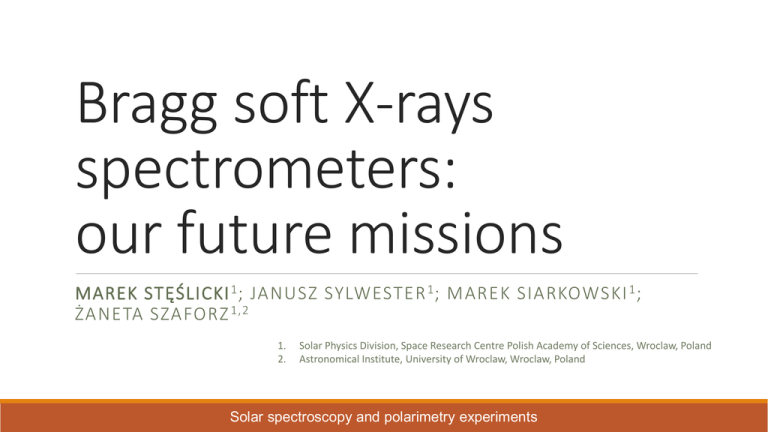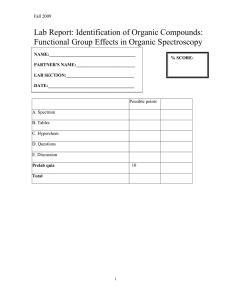Bragg soft X-rays spectrometers: our future missions MAREK STĘŚLICKI
advertisement

Bragg soft X-rays spectrometers: our future missions MAREK STĘŚLICKI 1 ; JANUSZ SYLWESTER 1 ; MAREK SIARKOWSKI 1 ; ŻANETA SZAFORZ 1,2 1. 2. Solar Physics Division, Space Research Centre Polish Academy of Sciences, Wroclaw, Poland Astronomical Institute, University of Wroclaw, Wroclaw, Poland Solar spectroscopy and polarimetry experiments Solar spectroscopy and polarimetry experiments SOLPEX CHEMIX SOLAR SPECTROSCOPY AND POLARIMETRY EXPERIMENTS 2 Motivation Reliable detection of X-ray polarisation provides unique, yet unexplored tool of studying nonisotropic distribution of particles in the solar corona Ubiquitous presence of collimated non-thermal electron beams during flare impulsive phase is indispensable in order to explain observed patterns of hard X-ray flare emission The X-ray polarization measurements have unique potential to constrain processes leading to the electron beaming and define the orientation of magnetic field loops with respect to line of sight SOLAR SPECTROSCOPY AND POLARIMETRY EXPERIMENTS 3 ISS Nauka module Nauka (Russian: Нау́ка; lit. Science), also known as the Multipurpose Laboratory Module (MLM) or FGB-2, (Russian: Многофункциональный лабораторный модуль, or МЛМ), is the major Russian laboratory module which will take the place of Pirs. SUN-pointing platform will be attached to NAUKA MLM Nauka module arrives to RKK Energia's KIS test facility in Korolev on Dec. 14, 2012. Credit: RKK Energia SOLAR SPECTROSCOPY AND POLARIMETRY EXPERIMENTS 4 SUN-pointing platform - Kortes Block of detectors – vacuum space outside the ISS on 2D-platform Block of electronics – inside the ISS Block of FIAN detectors: ◦ 2 telescopes – 171 and 304 Å (some other channel for technology & science testing) ◦ 2 spectroheliographs 180-210 Å & 280-330 Å ◦ X-ray spectropolarimeter SolPEX (0.5-15 keV) Kortes SOLAR SPECTROSCOPY AND POLARIMETRY EXPERIMENTS 7 SolPEX objectives Measurements of polarization in soft X-ray continuum emission and possibly in selected emission lines (1-2% detection limit) (B-POL) Measurements of X-ray spectra evolution with very high time resolution (0.1 s) rotating drum spectrometer (RDS) - idea proposed by Stefan Płocieniak Imaging the soft X-ray Sun with moderate spatial (~20arcsec) and high time resolution (0.1 s) pin-hole imager (PHI) SOLAR SPECTROSCOPY AND POLARIMETRY EXPERIMENTS 8 General view Pin-hole imager Rotating, bent-crystal Bragg spectropolarimeter with capillary 2D collimator and precision (arcsec) pointing device Rotating drum, flat crystal, multiple band Bragg-crystal spectrometer Front-end open-space electronics Design: Jarek Bąkała SRC PAS, Solar Physics Div. SOLAR SPECTROSCOPY AND POLARIMETRY EXPERIMENTS 9 Pin-hole imager Focal length ~60cm Spatial resolution: ◦ 0.5 mm hole ~2 arcmin (AR) ◦ 20 x 20 pixel area ◦ 0.1 mm hole ~30 arcsec (flare) Primary role: localize sources (AR & flares) on the disk in the instrument coordinate system Secondary: detect active phenomena on the disk, analyse individual lightcurves for separate AR Solar diameter: 200 x 200 pixels Easy concept: pin-hole (adjusted diameter open down to 0.1 mm, can be changed depending on the activity), CCD detector (256 x 1024 pixels 26 µ) FoV: 38 arcmin x 150 arcmin Image readout: each ~0.2 s ◦ 4 x 4 pixel area Will provide positions [x,y] of more prominent individual sources (resolution ~1.5 arcmin). Limited spectroscopy, similar to RHESSI at lower energy range (Fe XXV and Fe/Ni line groups distinguishable) Energy range: 1-10 keV, dE: ~1 KeV Purpose: Locate the X-ray source on the Sun SOLAR SPECTROSCOPY AND POLARIMETRY EXPERIMENTS 10 Rotating polarimeter unit Si 111 bent crystal at the Brewster angle ~45° CCD detector (1024x256 pixels) Rotating at 1 rev./s Pointed using pin-hole image SOLAR SPECTROSCOPY AND POLARIMETRY EXPERIMENTS 11 Spectro-Polarimeter monocrystal wafer: cylindrical Si 111 2d=6.271 Å Spectral range: 3.940 - 4.505 Å Radius of curvature: 180.0 mm Crystal length & width: 38.2 & 10 mm Calculated ideal FWHM & Resolution: 4.4 arcsec ~ 0.0005 Å < line thermal wdths courtesy Żaneta Szoforz SOLAR SPECTROSCOPY AND POLARIMETRY EXPERIMENTS 12 Why this selection? Continuum and line emission should be prominent for a wide range of physical conditions on the Sun i.e. AR and/or flares Sylwester et al. (2005) Clean spectral range in the vicinity of the lines, allowing for separate measurements for the continuum and line rotationally modulated pattern Average solar flare spectra, obtained by the RESIK instrument SOLAR SPECTROSCOPY AND POLARIMETRY EXPERIMENTS 13 A very high time resolution (0.1s) spectroscopy for flares New concept: Stefan Płocieniak SRC PAS Thanks to the rotation photons are being „reflected” from the crystal. By monitoring the photon arrival time, accurate „intercept” angle can be estimated & converted to wavelength Histogram spectrum will be revealed with sufficient amount of detections Fast rotating (10 rev/s) drum with a set of 8 crystals (4 pairs of identical flat monocrystals in Dopplerometer configuration) 4 large area ~0.25cm2 PIN detectors Rotating Drum Flat spectrometer unit SOLAR SPECTROSCOPY AND POLARIMETRY EXPERIMENTS 14 Solar X-ray Spectra from 0.3 A.U.: The CHEMIX Bragg spectrometer on Interhelioprobe ChemiX SOLAR SPECTROSCOPY AND POLARIMETRY EXPERIMENTS 15 Motivation oSpectra are formed in optically thin multi-million K plasmas; every formed photon escapes the source region (coronal part of active region or flare) oProminent continuum fomed in f-f, f-b, and two-photon processes o f-f bremsstrahlung (emitted by electrons passing protons) o f-b depends on plasma composition; important are more abundant elements (softer X-ray range) o Two-photon emission is weak ~100 × less important oLines seen in emission arise as a consequence of presence of heavier elements in trace quantities o Line intensities are proportional to abundance of elements o In the range 1.5 – 9Å, lines from Mg, Al, Si, S, Cl, Ar, K, Ca, Fe & Ni are seen in the spectra SOLAR SPECTROSCOPY AND POLARIMETRY EXPERIMENTS 16 X-ray spectrometers Requirements for Abundance Studies oGood spectral resolution, aqllowing lines of particular elements to be distinguished oGood sensitivity allowing to see lines of low abundance elements like Cl and K oReliable continuum level can be measured – this allows for absolute abundance determinations (relative to hydrogen) o Previously difficult to accomplish as the observed background usually contaminated by crystal fluorescence o Early Bragg spectroscopy: Intercosmos, P78, Hinotori, XRP on SMM, BCS on Yohkoh – always contaminated SOLAR SPECTROSCOPY AND POLARIMETRY EXPERIMENTS 17 Bent crystal Bragg reflections + positionsensitive detectors allow instantaneous record of spectra RESIK (2002-2003) SOLAR SPECTROSCOPY AND POLARIMETRY EXPERIMENTS 18 Subsystems of ChemiX oParticle detector (provides „own” instrument safety) o Issue flag to switch-OFF entire instrument or selected blocks in case of emergency (SEP, CME front passages) o Takes „standard” measurements of particle spectra o(Very) soft pin-hole CCD X-ray imager ~ 1 arcmin resolution o Detect S/C pointing based on the limb-brightening ring - provides detailed pointing (few arcsec accuracy) o Localize AR important in X-rays & follow their (separate) lightcurves o Identify flares within individual AR → provide target data to the pointing platform oInternal Target pointing platform carrying all crystals & CCDs o Within second lock the spectrometer on target oSpectral atlas spectrometer o Takes spectra in the range 1.5-9 Å regularly within selected FOV on the disk. DGI depends on the intensity- statistically defined threshold 10 000 counts over the spectrum o Provides spectral line & continuum intensities with unprecedented accuracy (2 × RESIK at perihelion) oDopplerometer (X-ray Tachometer) o Looks toward „differential” spectral line positions at the very high spectral resolution o Provides selected spectral line shapes at several points over the line profile SOLAR SPECTROSCOPY AND POLARIMETRY EXPERIMENTS 19 Instrument philosophy oTake measurements of soft X-ray spectra at the highest rate possible (every ~0.5 s) oStore the results into a large instrument internal data bank (256 GB) oBeam-down essential characteristics of measurements (lightcurves in selected spectral ranges), source coordinates oDownlink (when possible) „interesting” portions of data from the onboard memory SOLAR SPECTROSCOPY AND POLARIMETRY EXPERIMENTS 20 Summary Spectrometer-palarimeter B-POL will provide a measurments of the linear polarymetry both of the soft X-ray continuum and emission lines. New Bragg bent crystal spectrometers ADS and ChemiX for determination of elemental abundances from X-ray line spectra Multi-temperature analysis of elemental abundances, will be used, allowing for modelindependent precise determinations of absolute coronal plasma abundances Improved element abundance estimates will allow better understanding of FIP effect Spectra will improve plasma energy budget estimates through DEM and plasma motions SOLAR SPECTROSCOPY AND POLARIMETRY EXPERIMENTS 21 Thank you SOLAR SPECTROSCOPY AND POLARIMETRY EXPERIMENTS 22




